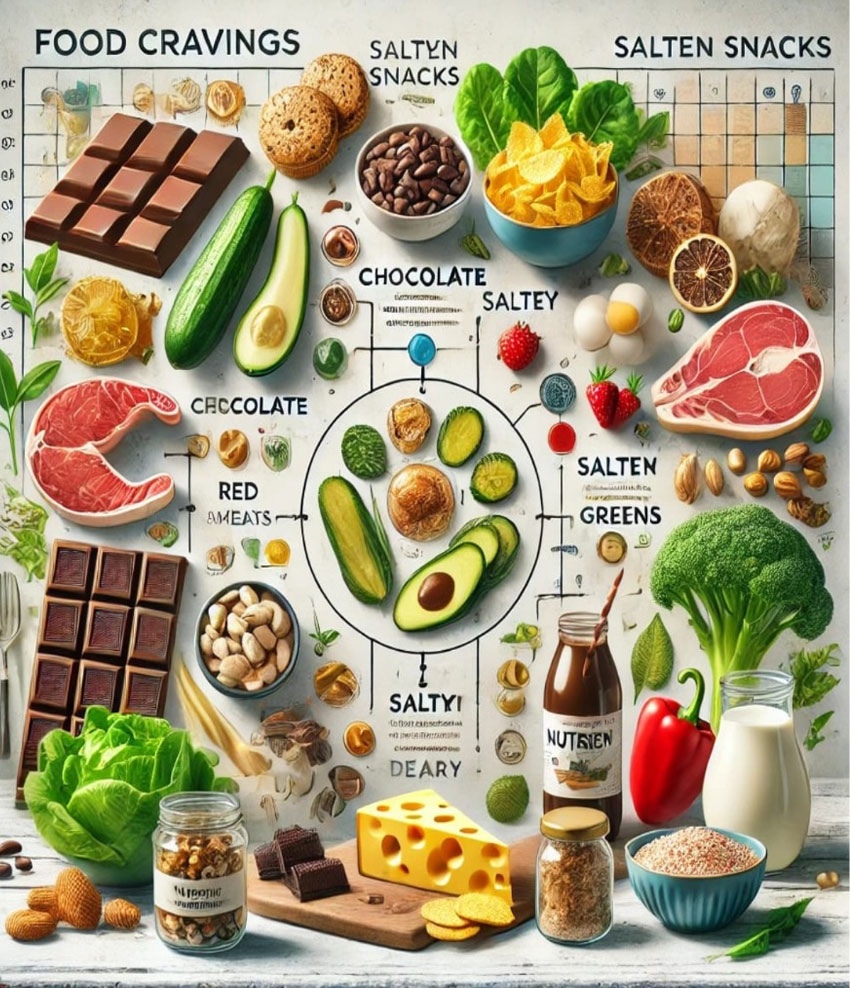
Cravings are intense desires for specific foods that many individuals experience. While they can stem from various factors, including emotional states and habits, a compelling aspect to consider is their potential connection to nutrient deficiencies. This article delves into how certain cravings might signal underlying nutritional gaps and offers insights into addressing them.
Understanding Cravings
Cravings are more than mere hunger; they are powerful urges for particular foods. These desires can be influenced by:
- Physiological Needs: The body’s requirement for specific nutrients.
- Emotional States: Stress, anxiety, or sadness leading to comfort eating.
- Hormonal Fluctuations: Changes during menstrual cycles or pregnancy affecting appetite.
Recognizing the root cause of cravings is essential for maintaining overall health and well-being.
Common Cravings and Their Potential Nutrient Links
- Chocolate
- Possible Deficiency: Magnesium
- Explanation: Chocolate, especially dark chocolate, is rich in magnesium. A craving for chocolate might indicate a need for this essential mineral, which plays roles in muscle function, nerve signaling, and energy production.
- Sources of Magnesium: Nuts, seeds, legumes, whole grains, and leafy green vegetables.
- Ice (Pagophagia)
- Possible Deficiency: Iron
- Explanation: The compulsive consumption of ice, known as pagophagia, has been linked to iron-deficiency anemia. Chewing ice may provide temporary relief to oral inflammation caused by anemia.
- Sources of Iron: Red meat, poultry, seafood, beans, dark leafy greens, and iron-fortified cereals.
- Salty Foods
- Possible Deficiency: Sodium or Chloride
- Explanation: An intense desire for salty snacks might suggest an electrolyte imbalance, particularly involving sodium or chloride. These minerals are vital for maintaining fluid balance and nerve function.
- Sources of Sodium and Chloride: Table salt, seafood, and vegetables like celery and tomatoes.
- Red Meat
- Possible Deficiency: Iron or Vitamin B12
- Explanation: Craving red meat could signal low levels of iron or vitamin B12, both crucial for red blood cell formation and preventing anemia.
- Sources of Vitamin B12: Fish, meat, poultry, eggs, and dairy products.
- Cheese or Dairy
- Possible Deficiency: Calcium or Vitamin D
- Explanation: A hankering for cheese or dairy products may indicate a need for calcium or vitamin D, essential for bone health and muscle function.
- Sources of Calcium: Dairy products, fortified plant-based milks, and leafy green vegetables.
- Sources of Vitamin D: Fatty fish, fortified dairy products, and exposure to sunlight.
- Sugary Foods
- Possible Deficiency: Chromium or Magnesium
- Explanation: A sweet tooth might be linked to low levels of chromium, which aids in blood sugar regulation, or magnesium, involved in glucose metabolism.
- Sources of Chromium: Broccoli, grapes, whole-grain products, and meats.
- Pickles or Sour Foods
- Possible Deficiency: Sodium
- Explanation: Craving pickles or sour foods can be a sign of sodium deficiency, especially in individuals with low blood pressure or those losing sodium through sweat.
- Fried or Fatty Foods
- Possible Deficiency: Essential Fatty Acids
- Explanation: A desire for fried foods may suggest a lack of essential fatty acids, necessary for brain function and hormone production.
- Sources of Essential Fatty Acids: Fatty fish, flaxseeds, walnuts, and chia seeds.
- Carbonated Drinks
- Possible Deficiency: Calcium
- Explanation: Some theories propose that craving fizzy drinks is linked to low calcium levels, though more research is needed in this area.
- The Broader Impact of Nutrient Deficiencies
Nutrient deficiencies can manifest in various ways beyond cravings. For instance:
- Iron Deficiency: Affects approximately one in three adults, leading to symptoms like fatigue, dizziness, and pica (craving non-nutritional substances). Addressing this requires incorporating iron-rich foods into the diet or considering supplements under medical guidance.
- Hidden Hunger: This term refers to subclinical nutrient deficiencies that don’t show immediate symptoms but can increase the risk of chronic diseases, including type 2 diabetes. A balanced diet rich in essential nutrients is crucial to combat this issue.
Addressing and Preventing Nutrient Deficiencies
To mitigate cravings linked to nutrient deficiencies:
- Balanced Diet: Ensure a varied diet that includes all essential nutrients. Incorporate fruits, vegetables, whole grains, lean proteins, and healthy fats.
- Regular Health Check-ups: Routine medical examinations can detect deficiencies early, allowing for timely interventions.
- Mindful Eating: Pay attention to hunger cues and cravings. Reflecting on what your body might be signaling can guide healthier food choices.
- Supplementation: When necessary, supplements can help address specific deficiencies. However, it’s essential to consult with a healthcare professional before starting any supplement regimen.
When to Seek Professional Help
If you experience persistent cravings or suspect a nutrient deficiency, consulting a registered dietitian or nutritionist is advisable. They can assess your dietary habits, identify potential deficiencies, and determine underlying causes, such as:
- Dietary Imbalances: Consuming foods that hinder nutrient absorption or lack essential nutrients.
- Malabsorption Issues: Conditions like celiac disease, Crohn’s disease, or environmental enteropathy can impair nutrient absorption, leading to deficiencies. For instance, environmental enteropathy, prevalent in low-resource settings, is characterized by chronic intestinal inflammation, reducing nutrient absorption and leading to malnutrition and stunted growth.
- Medication Interactions: Some medications can interfere with nutrient absorption. For example, metformin, a common diabetes medication, has been associated with vitamin B12 deficiency.
A healthcare professional can conduct necessary tests to diagnose deficiencies and recommend appropriate dietary adjustments or supplements.
Conclusion
Cravings can serve as insightful indicators of our body’s nutritional needs. By understanding the potential links between specific cravings and nutrient deficiencies, we can make informed dietary choices that promote overall health. Emphasizing a balanced diet, staying attuned to our body’s signals, and seeking professional guidance when needed are pivotal steps toward well-being.



